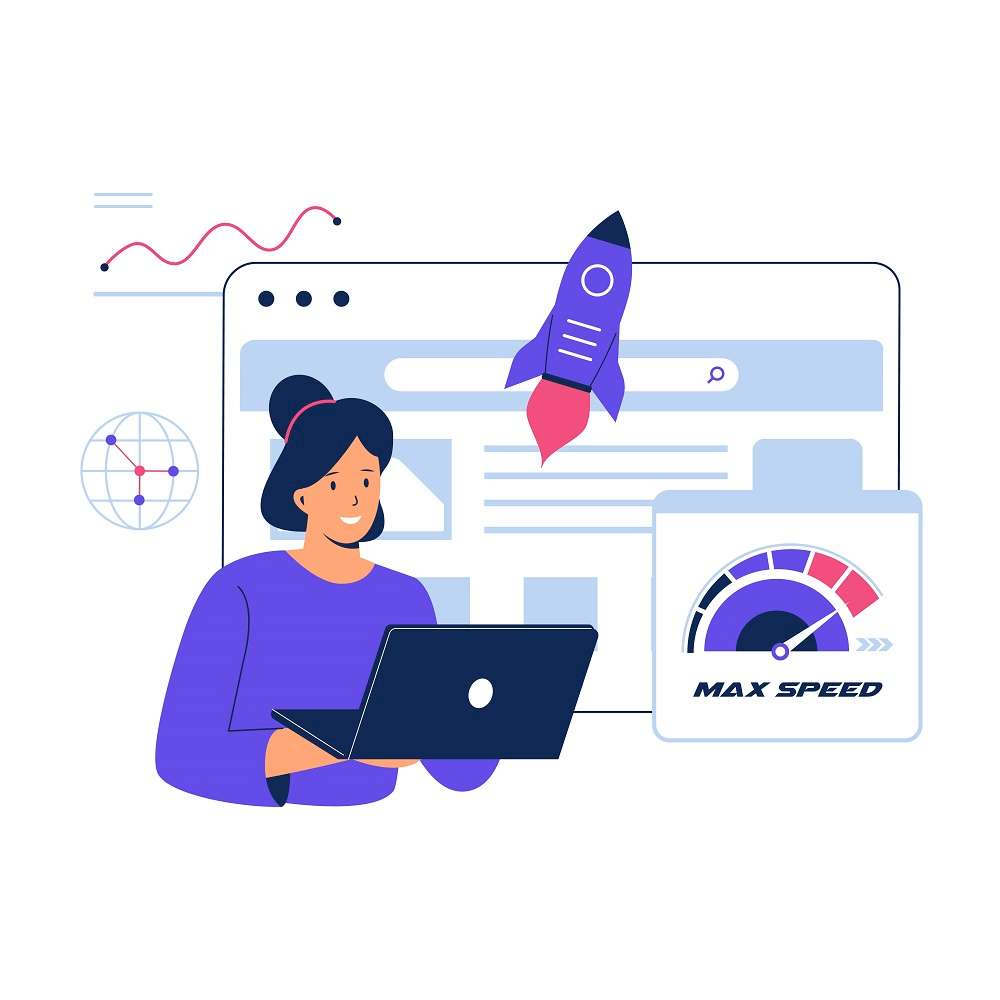How to Check Website Speed? - Tips & Tools for Faster Performance
Welcome to our blog where we look into the importance of checking website speed and how it can impact your online presence. In today's fast-paced digital world, users have become increasingly impatient, expecting websites to load within seconds. Slow-loading pages can frustrate visitors and lead to high bounce rates, negatively affecting your search engine rankings and conversion rates.
But fear not! In this blog, we will explore the various tools and techniques available to check your website's speed and optimize it for a better user experience. From analyzing page load times to identifying potential bottlenecks, we will guide you through the process of ensuring your website performs at its best.
Whether you're a business owner or a web developer, understanding and addressing website speed issues is crucial to staying ahead of the competition and providing a seamless online experience. So, let's dive in and unlock the secrets to a lightning-fast website!
How to Check Website Speed?
Importance of Website Speed

In today's digital landscape, understanding the importance of website speed is paramount for success. A. The impact of website speed on user behavior cannot be overstated. Research shows that users have little patience for slow-loading websites, often abandoning them in frustration.
A. slow site can lead to high bounce rates and decreased conversions.
B. Website speed also plays a crucial role in search engine rankings and SEO performance. Search engines like Google prioritize fast-loading websites, rewarding them with higher rankings and on the other hand, slow sites may be penalized, resulting in lower visibility and organic traffic.
C. Real-life case studies provide compelling evidence of the negative effects of slow website speed on businesses. From reduced sales to diminished customer satisfaction, the consequences can be significant.
By understanding and addressing website speed issues, businesses can enhance user experience, increase conversions, and improve their overall online performance. So, don't underestimate the impact of website speed – it can make or break your online success.
Factors Affecting Website Speed
When it comes to website speed, several factors come into play.
A. Website speed
- One of the key factors affecting website speed is hosting
- The quality and performance of your hosting provider can significantly impact load times.
- Additionally, factors like page size, code efficiency, image optimization, and excessive scripts can slow down your website.
- It's crucial to analyze and address these elements for optimal speed.
B. CDN
- Content Delivery Networks (CDNs) play a vital role in improving load times.
- CDNs distribute your website's content across multiple servers worldwide, reducing the distance between users and your site's data, this leads to faster load times, especially for users located far from your server's physical location.
- Implementing a CDN can have a significant impact on website speed and user experience.
C. Different Elements of Website Performance
Understanding how different elements contribute to overall website performance is essential. For instance, large images can cause slow load times, so optimizing image sizes and formats is crucial.
Similarly, minimizing the use of unnecessary scripts and optimizing code can enhance website speed. By addressing these factors and ensuring their optimal performance, you can create a fast and efficient website that keeps users engaged and satisfied. So, take the time to evaluate and optimize these elements for a lightning-fast website.
Tools for Checking Website Speed

1. Google PageSpeed Insights: Google PageSpeed Insights is a free tool that analyzes the performance of your website and provides suggestions to optimize its speed and user experience. It evaluates both mobile and desktop versions, giving you valuable insights to improve your website's loading time.
2. GTmetrix: GTmetrix is a powerful website performance testing tool that provides detailed analysis of your website's speed and performance. It offers a range of metrics, including page load time, total page size, and number of requests, helping you understand where improvements can be made to enhance your website's performance.
3. Pingdom: Pingdom is a popular website monitoring tool that allows you to test the speed of your website from different locations around the world. It provides a comprehensive performance report, highlighting areas that need attention, such as slow-loading elements or server issues, to ensure optimal website performance.
4. WebPageTest: WebPageTest is a highly regarded online tool that measures the performance of your website by simulating user interactions and analyzing various metrics. It offers detailed insights into page load time, first byte time, and other performance indicators, helping you identify bottlenecks and make informed optimization decisions.
5. YSlow: YSlow is a browser extension that evaluates web pages based on Yahoo's performance rules. It provides a grade and detailed analysis of different aspects affecting website speed, such as JavaScript and CSS optimization, caching, and server configuration. YSlow offers actionable recommendations to improve overall website performance.
6. SiteSpeed.io: SiteSpeed.io is an open-source tool that offers comprehensive website performance testing and analysis. It provides valuable insights into various performance metrics, including page load time, render time, and asset optimization. With SiteSpeed.io, you can identify performance bottlenecks and make data-driven optimizations to enhance user experience.
7. Lighthouse (Chrome DevTools): Lighthouse is an automated tool integrated into Chrome DevTools that helps developers improve the quality and performance of their websites. It audits web pages for performance, accessibility, best practices, and SEO, providing detailed reports and recommendations to optimize your website across various dimensions.
8. KeyCDN Website Speed Test: KeyCDN Website Speed Test is a user-friendly tool that allows you to measure your website's performance from different locations worldwide. It provides a comprehensive performance report, including metrics like page load time, time to first byte, and waterfall analysis. With KeyCDN, you can uncover bottlenecks and implement optimizations to enhance your website's speed.
Comparison and Analysis of Features Offered by Different Speed Testing Tools
1. Google PageSpeed Insights:
- Free tool that analyzes website performance and suggests optimizations.
- Evaluates both mobile and desktop versions.
- Provides scores and recommendations for improving performance.
- Offers insights into page load times, server response times, and more.
2. GTmetrix:
- Powerful website performance testing tool providing detailed analysis and metrics.
- Measures page load time, total page size, and more.
- Offers recommendations for optimizing website performance.
- Provides waterfall charts for visualizing resource loading.
3. Pingdom:
- Website monitoring tool that tests speed from different locations.
- Identifies issues like slow-loading elements or server problems.
- Provides comprehensive performance reports.
- Offers alerts and notifications for website downtime or performance issues.
4. WebPageTest:
- Highly regarded tool that measures performance by simulating user interactions and analyzing metrics.
- Allows testing from multiple locations and different browsers.
- Offers insights into page load time, first paint, and other performance metrics.
- Provides detailed waterfall charts and filmstrip view for analyzing page loading sequence.
5. YSlow:
- Browser extension that evaluates web pages based on performance rules.
- Provides grades and actionable recommendations for JavaScript, CSS, caching, and more.
- Offers insights into page components and their impact on performance.
- Provides detailed performance analysis and suggestions for improvement.
6. SiteSpeed.io:
- Open-source tool for comprehensive website performance testing and analysis.
- Measures page load time, render time, and more.
- Offers advanced analytics and visualizations for performance data.
- Provides recommendations for performance optimization.
7. Lighthouse (Chrome DevTools):
- Automated tool integrated into Chrome DevTools that audits websites for performance, accessibility, best practices, and SEO.
- Provides detailed reports and optimization suggestions.
- Offers insights into performance metrics, accessibility issues, and more.
- Allows testing on multiple devices and network conditions.
8. KeyCDN Website Speed Test:
- User-friendly tool to measure website performance from different global locations.
- Provides comprehensive performance reports and analysis.
- Measures metrics like page load time, time to first byte, and more.
- Offers waterfall charts and performance scores for visualizing and comparing results.
These speed-testing tools offer a variety of features and insights to help optimize website performance. Consider your specific needs, such as testing locations, metrics, and reporting capabilities, when choosing the tool that best suits your requirements.
Interpreting Website Speed Test Results
A. Understanding the metrics used to measure website speed:
When conducting website speed tests, it's essential to understand the metrics used to evaluate performance. Some common metrics include:
1. Page Load Time: The time it takes for a web page to fully load in the user's browser.
2. Time to First Byte (TTFB): The time it takes for the server to respond with the first byte of data.
3. Render Time: The time it takes for the browser to render the page and make it visible to the user.
4. Total Page Size: The combined size of all the files (HTML, CSS, JavaScript, images, etc.) needed to load the page.
B. Interpreting speed test scores and recommendations provided by testing tools:
Speed testing tools often provide scores and recommendations based on the analyzed data. These scores may vary depending on the tool used, but they generally indicate the overall performance of your website. It's important to consider the following while interpreting these scores:
1. Scores: Pay attention to scores provided by tools like Google PageSpeed Insights or GTmetrix. They usually give an indication of how well your website performs in terms of speed, optimization, and user experience.
2. Recommendations: These tools often provide recommendations for improving your website's speed and performance. Prioritize recommendations that are specific to your website, as they can have the most significant impact on performance.
C. Identifying areas that need improvement based on test results:
Analyzing the results of speed tests can help identify areas that require improvement. Consider the following factors while interpreting the test results:
1. Load Time Discrepancies: Look for significant variations in load times across different page elements. Identifying elements that take the longest to load can help pinpoint potential bottlenecks.
2. Render Blocking Resources: Check for resources (such as JavaScript or CSS files) that block the rendering of the page. These resources can delay the display of content and impact user experience.
3. Server Response Time: If the Time to First Byte (TTFB) is consistently high, it might indicate a slow server response. This can be improved by optimizing server configurations or utilizing caching mechanisms.
4. Page Size and Compression: Evaluate the total page size and assess whether it can be reduced. Compressing images or minifying code can significantly improve load times.
5. Network Latency: Consider the impact of network latency on your website's speed. If your target audience is spread across different regions, it may be worth testing from various locations to get a comprehensive view.
By understanding the metrics used, interpreting scores and recommendations, and identifying areas that need improvement, you can effectively optimize your website's speed and enhance user experience. Regular speed testing and analysis are crucial to maintaining optimal performance.
Strategies to Improve Website Speed

A. Optimizing images and media files for faster loading times:
Images and media files are often the largest contributors to page size, which can slow down website loading times. To improve speed, consider the following techniques:
Image Compression: Compress images without compromising quality using tools like Photoshop or online services. This reduces their file sizes and improves loading times.
Proper Image Formats: Choose the appropriate image format (JPEG, PNG, GIF, etc.) based on the content and level of detail required. This ensures efficient rendering and faster loading.
Lazy Loading: Implement lazy loading techniques to load images only when they are visible on the screen. This reduces the initial page load time and improves user experience.
B. Minimizing HTTP requests and reducing server response time:
The number of HTTP requests and server response time greatly impact website speed. Here are some strategies to minimize these factors:
Combine and Minify Files: Reduce the number of HTTP requests by combining CSS and JavaScript files. Minify these files by removing unnecessary characters and spaces. This boosts loading speed.
Content Delivery Networks (CDNs): Utilize CDNs to store website files in multiple locations worldwide. This reduces the physical distance between the user and the server, resulting in faster server response times.
Enable Gzip Compression: Compress files on the server using Gzip compression. This reduces file sizes and speeds up data transfer, improving overall website performance.
C. Compressing files, leveraging browser caching, and implementing code minification techniques:
To further improve website speed, consider implementing the following strategies:
File Compression: Compress HTML, CSS, and JavaScript files to reduce their sizes. This decreases the amount of data that needs to be transferred, resulting in faster loading times.
Browser Caching: Set appropriate expiry headers for static resources. This allows browsers to cache files, eliminating the need to download them again on subsequent visits. It reduces server load and speeds up page rendering.
Code Minification: Remove unnecessary characters, spaces, and comments from code files to reduce their size. This improves file transfer speed and reduces parsing time, leading to faster website performance.
By implementing these strategies to optimize images, minimize HTTP requests, reduce server response time, and compress files, you can significantly enhance your website's speed. Regularly monitor and test your website's performance to ensure ongoing optimization and an improved user experience.
Implementing Best Practices for Faster Websites
A. Selecting the right hosting provider and server configuration:
Choosing the right hosting provider and server configuration is crucial for website speed. Consider the following factors:
1. Reliable Hosting Provider: Select a hosting provider with a reputation for fast and stable servers. Look for providers that offer SSD storage and have data centers located near your target audience.
2. Optimal Server Configuration: Ensure that your server is properly configured for performance. This includes optimizing caching, enabling HTTP/2, and using a content delivery network (CDN) to reduce latency.
B. Using responsive design and mobile optimization for faster loading:
With the increasing use of mobile devices, it is essential to optimize your website for mobile users. Follow these practices:
1. Responsive Design: Implement a responsive design that automatically adjusts the layout and content based on the user's device. This eliminates the need for separate mobile versions of your website and improves loading times.
2. Mobile-Friendly Images: Optimize images for mobile devices by using the appropriate image formats and sizes. Compress and resize images to reduce file sizes without sacrificing quality.
3. Efficient Code and Scripts: Minimize the use of unnecessary code and scripts. Optimize JavaScript and CSS files, and avoid plugins or scripts that are not essential for your website's functionality.
C. Monitoring and regular maintenance to sustain website speed improvements:
Website speed optimization is an ongoing process. To sustain improvements, follow these practices:
1. Regular Performance Monitoring: Continuously monitor your website's performance using tools like Google PageSpeed Insights or GTmetrix. Identify areas that need improvement and take necessary actions.
2. Content Optimization: Regularly review and optimize your content, including images, videos, and text. Remove any outdated or unnecessary elements that may slow down your website.
3. System Updates and Maintenance: Keep your website's software, plugins, and themes up to date. Regularly check for security patches and bug fixes. Regular maintenance ensures optimal performance and helps prevent speed issues.
By implementing these best practices, you can significantly improve your website's speed and provide a better user experience. Remember to regularly monitor and maintain your website to sustain these improvements over time.
Conclusion
In conclusion, regularly checking and optimizing website speed is crucial for a positive user experience and online success. By implementing best practices such as selecting the right hosting provider, using responsive design, and optimizing images, you can ensure faster loading times and reduce bounce rates.
Continuously monitoring and striving for faster website speed not only enhances user satisfaction but also improves search engine rankings and overall website performance. Prioritizing website speed leads to increased engagement, conversions, and success in the digital landscape.





